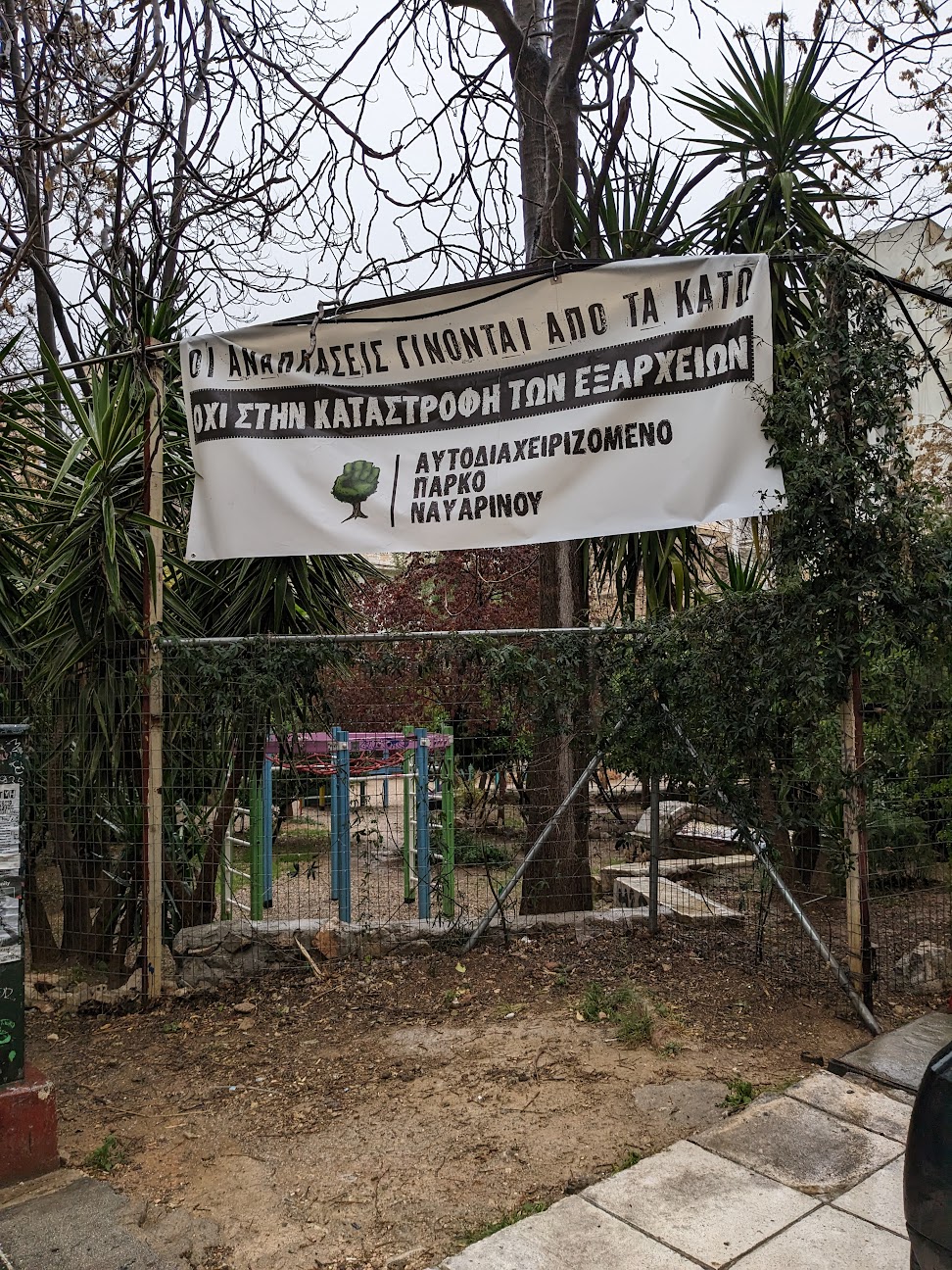Direct Action
Area: Community participation
“Every person who ever had a plan to do anything, and went and did it, or who laid [their] plan before others, and won their co-operation to do it with [them], without going to external authorities to please do the thing for them, was a direct actionist.”
(De Cleyre, 2009, p. 2)
Overview
Direct action is a term encompassing a variety of grassroots and bottom-up initiatives within the urban landscape. It is described as “a mode of disruptive activism” (Smith, 2018, p. 13) with an inherently political intention that may not necessarily be pacifist or legal -therefore likely to “be met with hostility” (Graeber, 2009, p. 359)- and is often associated with anti-capitalist, leftist and anarchist ideologies. Examples of direct action(s) include squatting, occupations, blockades and general strikes, among others (Smith, 2018; Sparrow, 1997). While definitions across activist and academic circles may vary, there is a convergence of opinions that emphasise two primary aspects: (1) direct action always describes a person or group’s own activity to “directly change perceived political, social or environmental injustices” (Doherty et al., 2003, p. 670) without third-party involvement; activities that employ representational and/or mediatory means (eg. lobbying) do not fall under the direct action umbrella (De Cleyre, 2009; Franks, 2003; Pouget, 2009; Smith, 2018; Sparrow, 1997). (2) Direct action is a prefigurative and synecdochic form of action; the action contains a tangible glimpse of the desired future in its end goal, in the methods used to achieve it, and in the identities of those involved in carrying it out (Franks, 2003; Pouget, 2009; Sparrow, 1997). Contrary to symbolic actions which are often contained in showcasing injustices, direct action can take the shape of a practical response and herald the larger vision it foreshadows.
Direct action in housing
Any direct action that tackles the housing question, operates on the premise that housing is a human right (UN Habitat, 2009), and aims at collectively producing “anti-capitalist housing alternative[s]” (Cattaneo et al., 2014, p. 50), against a backdrop of capitalist/neoliberal enclosures. Housing in this sense is understood as a “commons”, meaning that it is not only a resource that is (re)produced for the benefit of those (re)producing it, but also a “commitment to the creation of collective subjects [and the] fostering of common interests[…]” (Caffentzis & Federici, 2014, p. 103). The process and tactics that support direct actions in housing, could therefore be considered commoning. Hodkinson (2012) recognises 3 interdependent aspects of housing commoning: (1) prefigurative (living-in-common), (2) strategic (housing-as-commons), and (3) counter-hegemonic (circulating the housing commons) commoning.
Prefigurative commoning emphasises the desired way of living. It is essentially “try[ing] to meet our housing needs and desires through the creation of non-hierarchical, small-scale, directly democratic, egalitarian and collective forms of housing” (Hodkinson, 2012, p. 438). Strategic commoning refers to the “tactical interventions required to resist enclosure by both defending and creating housing commons as forms of protection against the market” (ibid.). Squatting falls under both of these definitions; it envisions a way of living that exists at the margins of the economic system, while at the same time it resists enclosure by reclaiming the right of equitable access to housing through the appropriation of vacant buildings, albeit in a standalone way. Lastly, counter-hegemonic commoning seeks to develop alliances between different housing movements and mobilisations, so that new forms of housing and living can be negotiated. Housing cooperatives fall under this type of commoning; while they do not directly challenge dominant housing systems, and therefore are not as inherently prefigurative as housing squats, they offer solid “dweller-control” alternatives that function as shields to speculation, financialisation, and market-driven agendas.
Potential and pitfalls
Direct actionists bring the shortcomings of neoliberal political agendas into stark relief, both by highlighting injustices, and by providing immediate, practical, albeit often small-scale and precarious responses. Nevertheless, the (commoning) process of planning, executing, and sustaining a direct action, much like any kind of activist endeavour, is a potentially unalienating activity that allows bonds of solidarity to flourish (Graeber, 2009), which, in turn, has the capacity to transform the consciousness of those involved (Sparrow, 1997). The oscillations between legality and illegality, along with the aforementioned transformative potential, may enable the decoupling from what Benjamin Franks calls “prescribed references” (2003, p. 19), i.e. any type of limitation or constraint legally and/or socio-culturally imposed by dominant elites. Finding or creating alternative “references”, may in turn be conceived as “an immediate practical alteration in power relations” (Franks, 2003, p. 32).
Criticism towards some aspects of direct action, however, often questions whether it can constitute a justifiable practice. Direct actions which employ violent, coercive or intimidating tactics may clash with the general public’s conception of the rights and obligations of citizens in a democratic society (Smith, 2018). Consequently, direct actions largely fall outside of the “normalised” activist practices spectrum, and often result in creating (in)tangible enclosures, which may fail to generate substantial impact. Conversely, normalising direct action in all its range of tactics and approaches would result in a paradox, since prescribing to externally conceived references would diminish its prefigurative potential.
Apart from questions on justifiability and normalisation, there is significant ambiguity regarding the types of methods and tactics employed in direct action, as well as their level of transferability. Since direct action is by definition counter-hegemonic, transferability in this case relates greatly to how power relations operate. Deleuze & Guattari argue that hegemonies operate in inherent situatedness, as they are shaped, sustained and perpetuated through connection and heterogeneity (2005). For direct action tactics to be successfully applied in diverse contexts, a nuanced understanding of contextual differences is vital.
Finally, while Voltairine de Cleyre’s definition may seem vague and all-encompassing, it highlights perhaps the most crucial aspect of direct action; the emancipatory potential of unmediated action on one’s own behalf.
References
Caffentzis, G., & Federici, S. (2014). Commons against and beyond capitalism. Community Development Journal, 49(SUPPL.1). https://doi.org/10.1093/cdj/bsu006
Cattaneo, C., Martínez, M. A., & Squatting Europe Kollective (Eds.). (2014). The squatters’ movement in Europe: Commons and autonomy as alternatives to capitalism. Pluto Press.
De Cleyre, V. (2009). Direct Action. https://theanarchistlibrary.org
Deleuze, G., & Guattari, F. (2005). A thousand plateaus: Capitalism and schizophrenia. University of Minnesota Press.
Doherty, B., Plows, A., & Wall, D. (2003). ‘The Preferred Way of Doing Things’: The British Direct Action Movement. Parliamentary Affairs, 56(4), 669–686. https://doi.org/10.1093/pa/gsg109
Franks, B. (2003). Direct action ethic. Anarchist Studies, 11(1), 13–41.
Graeber, D. (2009). Direct Action: An ethnography. AK Press. www.akpress.org.
Hodkinson, S. (2012). The return of the housing question. Ephemera, 12(4), 423–444.
Pouget, É. (2009). Direct Action. https://theanarchistlibrary.org/
Smith, W. (2018). Disruptive democracy: The ethics of direct action. Raisons Politiques, 69(1), 13–27. https://doi.org/10.3917/rai.069.0013
Sparrow, R. (1997). Anarchist Politics & Direct Action. https://theanarchistlibrary.org
UN Habitat. (2009). The Right to Adequate Housing. https://doi.org/10.1163/9789004502758_044
Created on 18-06-2024 | Update on 23-10-2024
Related definitions
Urban Commons
Area: Community participation
Created on 14-10-2022 | Update on 23-10-2024
Read more ->Spatial Agency
Area: Community participation
Created on 30-01-2024 | Update on 23-10-2024
Read more ->Design Activism
Area: Community participation
Created on 13-02-2024 | Update on 23-10-2024
Read more ->Related cases

Navarinou Park
Created on 03-10-2023
Related publications
Pappa, A., Tzika, Z., Roussou, E., & Panagidis, A. (2023, December). Informality as evidence: ethnographic insights from Southern European contexts. In KAEBUP 2023 Conference, Nicosia, Cyprus.
Posted on 02-01-2026
Conference
Read more ->Roussou, E., & Ricchiardi, A. (2024, May). Enclaves of commoning across the divide: Self-organised spaces against divisions. In AESOP Symposium: Constructing Peace through Public Space: What publics? Whose commons?. Nicosia, Cyprus
Posted on 02-01-2026
Conference
Read more ->
